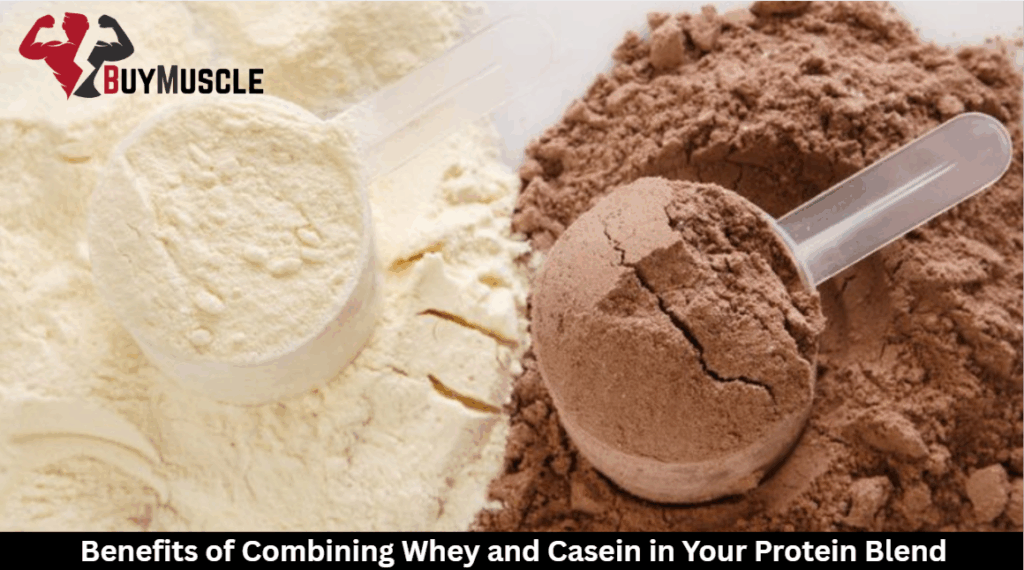When choosing a protein supplement, you may have heard the whey versus casein debate. What if you never had to choose? With these two protein powerhouses, immediate recovery and enhanced long-term muscle maintenance. Whey delivers rapid amino acid release while casein provides hours of sustained nourishment.
This strategic pairing addresses the complete recovery timeline in ways that neither protein can accomplish alone. The synergy might transform your results in ways you haven’t considered.
Understanding the Differences Between Whey and Casein
Even though they both come from milk, whey and casein work very differently in your body. Whey is the quick mover. It digests fast and hits your bloodstream in about 30 minutes. That rapid absorption jumpstarts muscle repair right away, which makes it perfect for post-workout recovery.
Casein protein, however, forms a gel-like substance in your stomach that slows digestion considerably. This results in a steady, prolonged release of amino acids that can last 6-8 hours. Where whey creates a quick spike in protein synthesis, casein prevents breakdown over extended periods.

Muscle Recovery and Protein Timing
Since your body requires different protein support throughout the day, timing your whey and casein intake strategically can maximize recovery benefits. After training, your muscles go into an anabolic response. It is the perfect time for whey’s rapid absorption properties in your post-workout shake.
But recovery isn’t limited to those first 30 minutes after exercise. Casein’s sustained release guarantees your muscles receive amino acids for hours afterward, particularly important during overnight fasting when muscle breakdown can occur. By combining both proteins, the body processes an immediate repair from whey, followed by extended support from casein.

Anabolic and Anti-Catabolic Benefits
Its complementary nature extends beyond timing strategies to physiological effects on muscle tissue. In a casein-based protein blend, you combine whey’s anabolic action to spur immediate muscle protein synthesis and casein’s anti-catabolic action to prevent breakdown during recovery periods.
This dual-action approach optimizes your body’s protein utilization, creating an ideal environment for lean muscle mass development. Whey triggers a rapid but short-lived spike in amino acids, while casein maintains elevated levels for hours afterward. Your protein supplementation becomes more efficient as this extensive amino acid profile addresses both growth and preservation needs simultaneously.
Rather than choosing between building new muscle or protecting existing tissue, the whey-casein combination lets you accomplish both goals with a single supplement.
Satiety, Digestion, and Daily Nutrition
Whey and casein proteins also impact your daily nutrition in different ways, including satiety and digestion. Slow-digesting casein gel forms in your stomach and extends satiety, helping you manage hunger between meals or during cutting phases.
Whey’s rapid digestion rate prevents bloating associated with protein consumption, making it ideal for pre-workout nutrition when you just want fuel without feeling sick. Such a complementary relationship creates practical benefits for your day. Nighttime casein will keep your muscles going during sleep, and Whey gives you the quick amino acids you need.
Best Times to Use a Whey-Casein Blend
Strategic timing of a whey-casein blend can dramatically enhance your fitness results by taking advantage of each protein’s unique properties. Post-workout consumption provides immediate recovery from whey while casein extends the amino acid delivery, optimizing your training nutrition strategy.
Before bedtime is another ideal opportunity. The time-release effect of casein prevents overnight muscle breakdown during your longest fasting period, while whey jumpstarts the recovery process. This combo preserves what you work for.
Consider taking a blend of meals if you cannot eat for hours. This approach keeps an even distribution of amino acids in your blood to help you maintain continuous muscle synthesis throughout the day and avoid the catabolic effects of prolonged periods without protein.
Choosing the Right Protein Blend Supplement
Choose a protein powder that clearly shows its whey-to-casein ratio, ideally something like 50:50 or 60:40. It helps you know exactly what you’re getting and allows you to match it to your goals. Elite athletes may need more whey for faster recovery or more casein for overnight muscle preservation.
Check the amino acid profile and protein content per serving. Minimize added sugars, artificial ingredients, or fillers. Digestive enzymes like lactase can be beneficial if you’re sensitive to dairy proteins.
Your training schedule should influence your choice, too. If you train multiple times daily, a faster-digesting blend might work better than for someone training once daily who needs sustained protein release.

Frequently Asked Questions
Can Vegetarians Use Whey-Casein Blends in Their Diet?
Yes, you can use whey-casein blends as a vegetarian since they come from milk, not meat. They’re perfectly compatible with vegetarian diets, though vegans should avoid them as they contain animal-derived ingredients.
How Do Whey-Casein Blends Affect Cholesterol Levels?
Whey-casein blends generally don’t raise cholesterol levels and may actually help improve your lipid profile. The proteins can support HDL (good cholesterol) while potentially lowering LDL (bad cholesterol) when used as part of a balanced diet.
Will Protein Blends Cause Weight Gain if I’m Not Training?
Protein blends won’t cause weight gain if you’re not training unless you consume excess calories. They’re just food. Any calories beyond what your body needs are fat.
Can I Mix Whey-Casein Powder With Hot Beverages?
You can mix whey-casein with warm (not boiling) beverages, but heat may affect texture and nutritional quality. Aim for temperatures under 140°F to preserve protein structure and prevent clumping or unpleasant taste.
Do These Blends Contain Artificial Hormones From Dairy Sources?
Quality whey-casein blends typically use hormone-free dairy sources. Check product labels for “rBGH-free” or “hormone-free” claims to guarantee you’re avoiding artificial hormones in your protein supplement.








